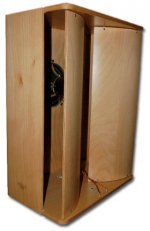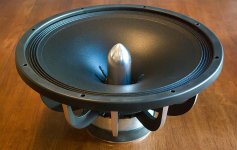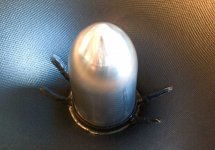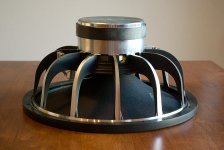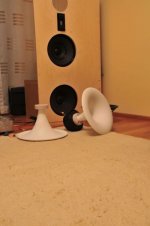Anyone has any idea what those back wings on Solovox do?
http://www.6moons.com/audioreviews/auditorium232/solovox.html
http://www.6moons.com/audioreviews/auditorium232/solovox.html
Attachments
Electra Print stocks them.
soongsc said:Are there there autoformers that are standard parts?
Difuse the back wave. Magnetar talked about doing this on his open baffles.
agent.5 said:Anyone has any idea what those back wings on Solovox do?
http://www.6moons.com/audioreviews/auditorium232/solovox.html
agent.5 said:Anyone has any idea what those back wings on Solovox do?
http://www.6moons.com/audioreviews/auditorium232/solovox.html
I would guess interfere with/ re-direct the rear wave, thereby modifying what would otherwise be a reflected interference peak from walls behind the baffle.
Might well tame the peak which can often arise between 60 and 120Hz due to wall/ corner reflection of rear wave from plain baffles, and allow 'adjustment' for individual corner responses which might otherwise distract through being difficult to tame.
Hi Lynn
Actually, regarding the Aurora, which was in many ways a terrific amp by the way , I don't feel my own uncertainty about the final version was entirely due to the SE stage . I think the ironwork is critical in there, and Bud has most likely fixed the issues in the earlier part of the circuit with the new designs . Also, I was always confusing the amp comparisons in my own mind with the results I got out of 2A3 SE . I've finally concluded that no matter what driver you use ( and I've tried DHTs eg 45's ) , there's no making a 300B sound like a 2A3 in the HF .
One aim of making these new more efficient speakers is to be able to use 2A3 SE or 2A3 PP ( Amity revisited ) in the future .
Thanks for the other info which I will mull over .
I may e-mail J-M L C soon too ...
Mark
Actually, regarding the Aurora, which was in many ways a terrific amp by the way , I don't feel my own uncertainty about the final version was entirely due to the SE stage . I think the ironwork is critical in there, and Bud has most likely fixed the issues in the earlier part of the circuit with the new designs . Also, I was always confusing the amp comparisons in my own mind with the results I got out of 2A3 SE . I've finally concluded that no matter what driver you use ( and I've tried DHTs eg 45's ) , there's no making a 300B sound like a 2A3 in the HF .
One aim of making these new more efficient speakers is to be able to use 2A3 SE or 2A3 PP ( Amity revisited ) in the future .
Thanks for the other info which I will mull over .
I may e-mail J-M L C soon too ...
Mark
i am using these german autotrafos with good results :
http://cgi.ebay.de/Auto-Transformer...435606&_trksid=p3911.c0.m14&_trkparms=72:1229|66%3A4|65%3A12|39%3A1|240%3A1318
http://cgi.ebay.de/Auto-Transformer...435606&_trksid=p3911.c0.m14&_trkparms=72:1229|66%3A4|65%3A12|39%3A1|240%3A1318
caninus80 said:Lynn,
Did You make any photo of AE Lo15?
Cant wait to see Your opinion about those drivers...
Same!
Whoa! The Altec Biflex and 416A are really good drivers. I'd hand on to the Altecs a while longer, and see for yourself how the Lambdas compare. The Altecs are low-Q, of course, and not an effective choice for the low end of a dipole speaker. You might try a pair or quartet of the Dipole15 (LO), use them as bass augmenters (low-pass filtered just below the baffle peak), and see how they complement the Altecs you have now.
Since the cones and suspension are similar, and the Dipole15 (LO) have underhung voice coils (same as Altec), they should have a similar sonic character and work well together. Part of the reason for specifying the combination of Dipole15 and TD15M traits is to optimize the new driver to complement Altec-style 12 and 15-inch drivers - there are a lot of them out there, and the Dipole15 (LO) is intended to make them suitable for OB use. I was thinking of a much broader market than just my own little project.
On a similar note, there are two intended applications for the AH-425 horn: the first is a large-format mid/horn to complement studio-monitor 12 and 15" drivers, and the second is to complement midbass horns that extend up to 800 Hz.
Martin, if you're reading this, I'm curious what your impressions between using the Lowther all the way up to its rolloff point around 12~13 kHz, and the compression driver you're now using in the same range. I'd guess the mids sound more open, relaxed, and effortless, with a more spacious and "tactile" quality. But that's only a guess. Curious what your impression has been.
Since the cones and suspension are similar, and the Dipole15 (LO) have underhung voice coils (same as Altec), they should have a similar sonic character and work well together. Part of the reason for specifying the combination of Dipole15 and TD15M traits is to optimize the new driver to complement Altec-style 12 and 15-inch drivers - there are a lot of them out there, and the Dipole15 (LO) is intended to make them suitable for OB use. I was thinking of a much broader market than just my own little project.
On a similar note, there are two intended applications for the AH-425 horn: the first is a large-format mid/horn to complement studio-monitor 12 and 15" drivers, and the second is to complement midbass horns that extend up to 800 Hz.
Martin, if you're reading this, I'm curious what your impressions between using the Lowther all the way up to its rolloff point around 12~13 kHz, and the compression driver you're now using in the same range. I'd guess the mids sound more open, relaxed, and effortless, with a more spacious and "tactile" quality. But that's only a guess. Curious what your impression has been.
Hello Lynn,
What's your opinion for bass augmenter (as low as possible to around120hz) between the Dipole15 (normal version) and the Hawthorne Augie 15"?
I do not plan to use special damping (for WAF), some wings and pretty narrow baffle. Mids and top-end are as per the default Bastanis Atlas setup.
What's your opinion for bass augmenter (as low as possible to around120hz) between the Dipole15 (normal version) and the Hawthorne Augie 15"?
I do not plan to use special damping (for WAF), some wings and pretty narrow baffle. Mids and top-end are as per the default Bastanis Atlas setup.
perhaps slightly OT, but this Veena loudspeaker seems like an effective configuration, with 4 OB 10s per side and a Lowther for the mid-hi:
http://www.dagogo.com/AcousticPlanVeena.html
http://www.dagogo.com/AcousticPlanVeena.html
Russell Dawkins said:perhaps slightly OT, but this Veena loudspeaker seems like an effective configuration, with 4 OB 10s per side and a Lowther for the mid-hi:
http://www.dagogo.com/AcousticPlanVeena.html
Just a factoid for people that want to buy pre-made curve panels, or large radius corners.
http://www.aitwood.com/StoreFront.Asp?WoodType=MDFJ&CATID=10&Section=MDFJQTRRND&wDesc=MDF Prefit (J)%20Quarter%20Rounds
Click on millworks components
then select curved plywood catalog
agent.5 said:
Just a factoid for people that want to buy pre-made curve panels, or large radius corners.
http://www.aitwood.com/StoreFront.Asp?WoodType=MDFJ&CATID=10&Section=MDFJQTRRND&wDesc=MDF Prefit (J)%20Quarter%20Rounds
Click on millworks components
then select curved plywood catalog
I would love to find something like that in EU...
- Home
- Loudspeakers
- Multi-Way
- Beyond the Ariel
